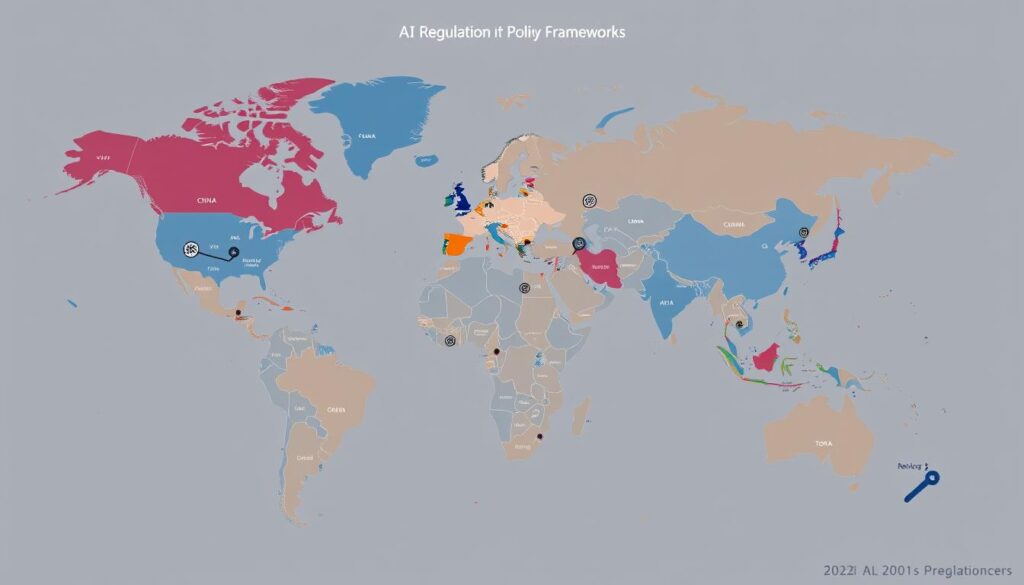What happens when groundbreaking technology evolves faster than the rules governing it? As intelligent systems reshape industries, policymakers face a critical dilemma: how can regulations protect personal data without stifling innovation? The answer lies in understanding today’s rapidly shifting legal landscape.
The U.S. currently lacks unified federal laws addressing artificial intelligence. Recent executive actions reflect competing priorities—President Biden’s 2023 order emphasized safety and accountability, while the 2025 reversal prioritized industry growth. This creates a patchwork of state-level rules and voluntary guidelines that challenge businesses to navigate.
Globally, the European Union’s AI Act sets rigorous standards for transparency and risk assessment. Meanwhile, American lawmakers debate bills focusing on algorithmic accountability and data usage limits. Organizations must now reconcile these divergent approaches while managing risks like unintended bias or data repurposing in machine learning models.
Key Takeaways
- No comprehensive U.S. federal laws currently govern artificial intelligence systems
- Executive orders show shifting priorities between innovation and accountability
- EU regulations contrast sharply with America’s fragmented approach
- Emerging state laws create compliance challenges for national operations
- Algorithmic transparency remains a core regulatory focus area
Understanding the Landscape of AI Privacy Legislation

Global efforts to govern advanced technologies reveal stark contrasts in priorities and enforcement strategies. The European Union’s AI Act leads with binding rules for high-risk applications, requiring impact assessments and human oversight. Meanwhile, U.S. approaches remain fragmented, relying on voluntary guidelines and existing sector-specific laws.
Key Regulatory Frameworks
Europe’s comprehensive system categorizes tools by risk level—banning manipulative social scoring while mandating strict testing for medical diagnostics. Across industries like healthcare and telecommunications, specialized rules add layers to financial sector compliance. The White House Blueprint outlines five principles but stops short of legal mandates, creating uncertainty for developers.
Gaps in Current Federal Laws
No U.S. statute specifically addresses algorithmic decision-making processes. Existing protections against biased outcomes derive from decades-old civil rights laws ill-suited for modern systems. Critical weaknesses include:
- No standardized auditing requirements for automated tools
- Vague disclosure rules about data usage in training models
- Inconsistent protections across state jurisdictions
International groups like OECD now push for shared standards, but domestic implementation remains years away. This regulatory vacuum forces organizations to self-police while awaiting clearer directives.
Global AI Regulatory Trends and International Perspectives

Nations worldwide are charting distinct paths in governing advanced technologies, reflecting cultural values and economic ambitions. While some regions enforce binding rules, others prioritize innovation through flexible frameworks—creating a complex web of compliance requirements.
Comparative Views from Europe, Asia, and Beyond
The European Union’s risk-based framework remains the gold standard, mandating strict assessments for tools used in healthcare and law enforcement. China counters with targeted administrative measures for generative systems, requiring security reviews before public release.
Key regional approaches include:
- Japan’s soft law strategy encouraging self-regulation in robotics
- Canada’s proposed Artificial Intelligence and Data Act (AIDA) for federal oversight
- Australia’s voluntary ethics principles emphasizing transparency
“Effective governance requires balancing innovation with accountability—a challenge magnified by rapid technological change.”
Emerging economies face unique hurdles. The African Union’s Continental Strategy promotes unified standards while addressing infrastructure gaps. Brazil’s stalled legislation highlights debates over financial sector compliance costs versus consumer protections.
Multilateral efforts gain momentum as the Council of Europe drafts binding human rights safeguards. However, conflicting national priorities complicate cross-border data flows—a critical issue for companies deploying machine learning systems globally.
United States: Federal and State Regulatory Dynamics

The U.S. regulatory framework for advanced technologies operates through a layered system of federal guidance and evolving state mandates. While no comprehensive federal law currently governs these systems, agencies apply decades-old statutes to modern challenges—creating a mosaic of compliance expectations.
Existing Federal Guidelines
Federal oversight relies on repurposed laws like the National AI Initiative Act, which prioritizes research over binding rules. Sector-specific regulators—including the FTC and FCC—enforce existing consumer protection statutes for automated decision-making tools. This approach leaves gaps in standardized auditing and data usage disclosures.
Emerging State Legislation
States are filling regulatory voids with localized solutions. Over 40 bills addressing automated tools emerged in 2023, with Connecticut and Texas establishing task forces to prevent bias in government systems. These groups assess potential discrimination risks in public-sector applications, reflecting growing concerns about financial sector compliance and civil rights impacts.
The clash between federal flexibility and state-specific laws creates operational hurdles. Companies must track conflicting requirements across jurisdictions while preparing for potential federal legislation. This dynamic underscores the need for adaptable governance models as technological capabilities outpace policy development.
California Consumer Privacy and Its Impact on AI
California continues to set the benchmark for technology governance with its latest suite of AI-focused regulations. Building on the California Consumer Privacy Act, new measures address automated decision-making tools while expanding safeguards for personal information in emerging applications.
Latest AI-Specific Laws in California
September 2024 saw multiple bills reshape the state’s regulatory framework. Senate Bill 942 requires clear labeling of AI-generated content, with fines up to $500,000 for violations. Assembly Bill 2013 mandates public summaries of training data used in generative systems—a move addressing concerns about bias in financial sector compliance tools.
Other key measures include:
- Digital Replica Act (AB 1836) protecting deceased individuals’ likenesses
- Healthcare AI Act (AB 3030) establishing oversight for medical diagnostic tools
Challenges for Compliance in Consumer Privacy
Organizations face three primary hurdles under California’s framework. First, implementing detection systems for AI-generated content requires costly technical upgrades. Second, maintaining transparency reports for training data creates administrative strain. Third, evolving interpretations of “automated decision-making” leave room for legal disputes.
The California Privacy Protection Agency’s draft rules compound these challenges by requiring detailed disclosures about personal information usage. As other states observe California’s approach, businesses must prepare for potential nationwide ripple effects.
Data Protection and the Evolving Nature of Personal Information
Modern data ecosystems now face unprecedented challenges as automated systems generate new forms of identifiable content. California’s Assembly Bill 1008 redefines personal information to include outputs from algorithmic processes, effective January 2025. This update to the CCPA requires businesses to treat machine-generated insights as equivalent to directly collected personal data.
Three primary pathways enable systems to create sensitive content:
- Pattern recognition across existing datasets
- Behavioral inference models
- Synthetic content generation referencing real individuals
These capabilities force organizations to redesign financial sector compliance protocols. Traditional frameworks struggle with algorithmic outputs that combine thousands of data points into unexpected profiles.
| Aspect | Traditional Data | AI-Derived Data |
|---|---|---|
| Source | Direct user input | Algorithmic analysis |
| Collection Method | Intentional gathering | Automated generation |
| Compliance Focus | Storage & access | Output monitoring |
| Risk Profile | Known breaches | Emergent inferences |
AB 1008 mandates equal protection for all forms of personal information, regardless of origin. Companies must implement dual safeguards: securing input datasets while monitoring generated outputs for unintended disclosures. Retention policies now require scrutiny of how processed data might evolve beyond initial collection purposes.
The law’s broad scope impacts sectors using predictive analytics or generative tools. Compliance teams face new obligations to audit system outputs and update breach response plans for synthetic content scenarios.
Privacy Act, Consumer Rights, and AI Integration
Navigating the intersection of technological progress and personal protections presents one of modern governance’s most intricate challenges. As automated systems reshape decision-making processes, existing legal frameworks must adapt to safeguard fundamental rights while fostering responsible innovation.
Balancing Innovation and Privacy
Major technology firms—including Google, Microsoft, and IBM—have pledged voluntary commitments to security testing and risk management. These initiatives demonstrate growing industry recognition of public concerns about opaque algorithmic processes. For example, consumer rights now increasingly demand explanations for automated decisions affecting employment or financial opportunities.
Obligations for Companies Under Current Laws
Organizations face layered responsibilities when deploying advanced systems. Compliance requires implementing privacy by design principles and maintaining audit trails for training data. Regulations like Canada’s Artificial Intelligence and Data Act propose risk-based oversight models that could influence global standards.
Three critical obligations dominate compliance efforts:
- Providing clear disclosures about automated data processing
- Enabling human review of impactful system decisions
- Designing interfaces that support rights to access or delete information
As legal expectations evolve, businesses must prioritize adaptable frameworks that protect individuals without stifling beneficial applications. The path forward lies in collaborative efforts between policymakers and developers to align technical capabilities with societal values.







